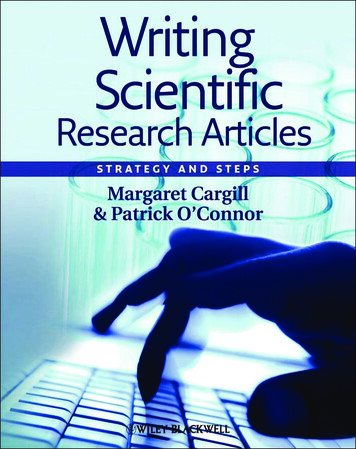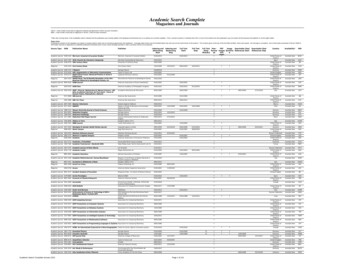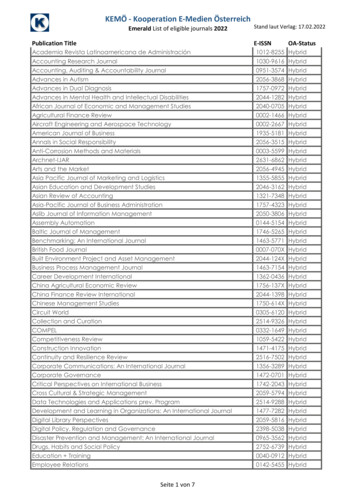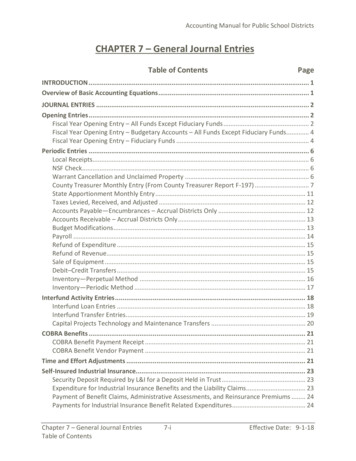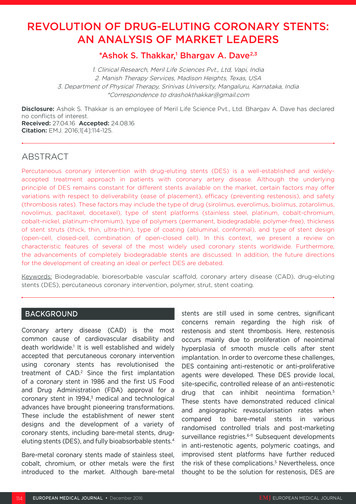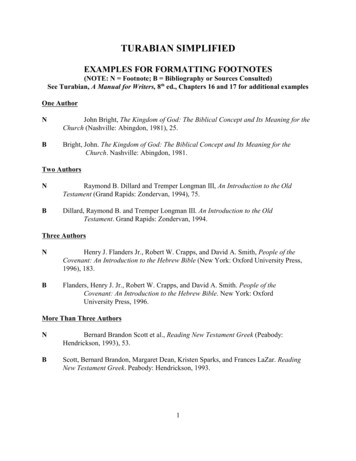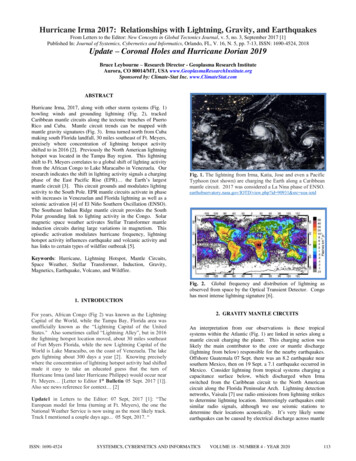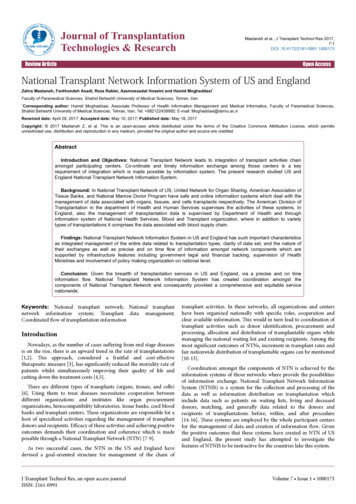
Transcription
Journal of TransplantationTechnologies & Researchogolies & Resel of Transplanation TechnntaISSN: 2161-0991Mastaneh et al., J Transplant Technol Res 2017,7:1DOI: 10.4172/2161-0991.1000173Open AccesscharJourReview ArticleNational Transplant Network Information System of US and EnglandZahra Mastaneh, Farkhondeh Asadi, Reza Rabiei, Azamossadat Hoseini and Hamid Moghaddasi*Faculty of Paramedical Sciences, Shahid Beheshti University of Medical Sciences, Tehran, Iran*Corresponding author: Hamid Moghaddasi, Associate Professor of Health Information Management and Medical Informatics, Faculty of Paramedical Sciences,Shahid Beheshti University of Medical Sciences, Tehran, Iran, Tel: 982122439982; E-mail: Moghaddasi@sbmu.ac.irReceived date: April 26, 2017; Accepted date: May 10, 2017; Published date: May 18, 2017Copyright: 2017 Mastaneh Z, et al. This is an open-access article distributed under the terms of the Creative Commons Attribution License, which permitsunrestricted use, distribution and reproduction in any medium, provided the original author and source are credited.AbstractIntroduction and Objectives: National Transplant Network leads to integration of transplant activities chainamongst participating centers. Co-ordinate and timely information exchange among those centers is a keyrequirement of integration which is made possible by information system. The present research studied US andEngland National Transplant Network Information System.Background: In National Transplant Network of US, United Network for Organ Sharing, American Association ofTissue Banks, and National Marrow Donor Program have safe and online information systems which deal with themanagement of data associated with organs, tissues, and cells transplants respectively. The American Division ofTransplantation in the department of Health and Human Services supervises the activities of these systems. InEngland, also the management of transplantation data is supervised by Department of Health and throughinformation system of National Health Services, Blood and Transplant organization, where in addition to varietytypes of transplantations it comprises the data associated with blood supply chain.Findings: National Transplant Network Information System in US and England has such important characteristicsas integrated management of the entire data related to transplantation types, clarity of data set, and the nature oftheir exchanges as well as precise and on time flow of information amongst network components which aresupported by infrastructure features including government legal and financial backing, supervision of HealthMinistries and involvement of policy making organization on national level.Conclusion: Given the breadth of transplantation services in US and England, via a precise and on timeinformation flow, National Transplant Network Information System has created coordination amongst thecomponents of National Transplant Network and consequently provided a comprehensive and equitable servicenationwide.Keywords: National transplant network; National transplantnetwork information system; Transplant data management;Coordinated flow of transplantation informationIntroductionNowadays, as the number of cases suffering from end stage diseasesis on the rise, there is an upward trend in the rate of transplantations[1,2]. This approach, considered a fruitful and cost-effectivetherapeutic measure [3], has significantly reduced the mortality rate ofpatients whilst simultaneously improving their quality of life andcutting down the treatment costs [4,5].There are different types of transplants (organs, tissues, and cells)[6]. Using them to treat diseases necessitates cooperation betweendifferent organizations and institutes like organ procurementorganizations, histocompatibility laboratories, tissue banks, cord bloodbanks and transplant centers. These organizations are responsible for ahost of specialized activities regarding the management of transplantdonors and recipients. Efficacy of these activities and achieving positiveoutcomes demands their coordination and coherence which is madepossible through a National Transplant Network (NTN) [7-9].As two successful cases, the NTN in the US and England havedevised a goal-oriented structure for management of the chain ofJ Transplant Technol Res, an open access journalISSN: 2161-0991transplant activities. In these networks, all organizations and centershave been organized nationally with specific roles, cooperation andclear available information. This would in turn lead to coordination oftransplant activities such as donor identification, procurement andprocessing, allocation and distribution of transplantable organs whilemanaging the national waiting list and existing recipients. Among themost significant outcomes of NTNs, increment in transplant rates andfair nationwide distribution of transplantable organs can be mentioned[10-13].Coordination amongst the components of NTN is achieved by theinformation systems of those networks where provide the possibilitiesof information exchange. National Transplant Network InformationSystem (NTNIS) is a system for the collection and processing of thedata as well as information distribution on transplantation whichinclude data such as patients on waiting lists, living and deceaseddonors, matching, and generally data related to the donors andrecipients of transplantations before, within, and after procedure[14-16]. These systems are employed by the whole participant centersfor the management of data and creation of information flow. Giventhe positive outcomes that these systems have created in NTN of USand England, the present study has attempted to investigate thefeatures of NTNIS to be instructive for the countries lake this system.Volume 7 Issue 1 1000173
Citation:Mastaneh Z, Asadi F, Rabiei R, Hoseini A, Moghaddasi H (2017) National Transplant Network Information System of US and England. JTransplant Technol Res 7: 173. doi:10.4172/2161-0991.1000173Page 2 of 5Literature SurveyManagement of transplant services in the USEarly transplantations in the US date back to 1870. Numerous tissuetransplants including cornea, skin, joints and blood vessels werecompleted successfully in that decade and in the following years. Asthese transplants developed further, there was the need to establishcenters to manage tissue processing and procurement. This led to theestablishment of the first tissue bank in 1949 which was capable ofrecovering, processing, storing and distributing different tissuesscientifically [17]. With the ever-growing number of such banks,American Association of Tissue Banks (AATB) was founded to provideuniform services in transplant centers by making them coordinatedand coherent [18]. Moreover, the AATB devised comprehensive andclear standards and regulations to improve the quality and immunityof donated tissues and provide fair and comfortable access to them tocater for domestic needs [19,20].Concomitantly, as the tissue transplant expanded, the bed was beingmade for organ transplants as well. It was in 1968 that the first OrganProcurement Organization was established. Also, the Southeast OrganProcurement Foundation was formed with the aim of quick and fairdistribution of donated organs. This foundation developed the firstcomputerized system able of finding appropriate transplant candidatesthrough donor-recipient compatibility and in order to provide theseservices nationwide, it was renamed in 1984 to United Network forOrgan Sharing (UNOS). Meanwhile, the National Organ TransplantAct was passed in the congress thereby prohibiting the sales of humanorgans. Also, the government was obliged to establish an OrganProcurement and Transplant Network (OPTN) which emphasized onestablishing, developing and specializing cooperating organizationsand centers in this regard. In 1986, the US Department of Health andHuman Services was, based on this legal obligation, charged withsigning the contract with the privately owned UNOS to implementOPTN. The purpose of establishing this network was fair allocationand distribution of donated organs through coordination ofparticipating centers [21,22].There were also other efforts towards hematopoietic stem celltransplant. These were conducted by National Marrow Donor Program(NMDP) supervised by the HHS [23]. The main purpose of thisorganization was to make possible cell transplants from volunteerunrelated donors; being there no compatible donors among therelatives of approximately 70% of the patients. In order to achieve thisobjective, “Be the Match” was created by the national registry in whichnow reside the contact details of 11 million volunteer donors and193000 cord blood units as well. Furthermore, the NMDP managescollecting and processing of stem cells, the transplant procedure,follow up of donors and recipients after the transplant and ensurestheir safety [24].According to the aforementioned facts, it is clear that the transplantprocess in the US is a result of the need for any type of transplant(organs, tissues, and cells) through time. Currently, these activities aremanaged by a network of three mentioned organizations i.e., UNOS,AATB and NMDP [25–27]. These organizations which shape theAmerican NTN are supervised by the Division of Transplantation(DoT) in the HHS [10]. This entity would devise general policies toguide the network and supervise the implementation of such policiesby the abovementioned organizations [28,29].J Transplant Technol Res, an open access journalISSN: 2161-0991Each of these organizations encompasses a series of coherent centersin order to accomplish their tasks. Accordingly, the UNOS includesorgan procurement organizations, histocompatibility laboratories, andorgan transplant centers. The AATB also oversees the tissue banks andtissue transplant centers. The components of the organizationresponsible for executing NMDP are recruitment centers, donationcenters, stem cell collection centers, apheresis centers, cord bloodbanks, histocompatibility laboratories and stem cell transplant centers.All these centers are of clear duties and interrelations under theiroverseeing organization. The existence of organized communicationbetween these centers has led to further coordination in the chain ofactivities from identification of donors to the transplant follow ups[30-32].The above mentioned organizations have their own structuredentities to devise executive policies and operational proceduresregarding transplant. These policies are put forward by specializedcommittees and are to be assessed and approved by the HHS fornationwide execution [24,28,30-32]. One of the most importantpolicies relates to how transplantable parts are allocated to the existingpatients on the waiting list. They are devised according to scientificprinciples and criteria and can result in fair distribution of transplantproducts throughout the country [33].The American NTN enjoys strong computerized infrastructuresused to exchange information between transplant centers. This dataexchange is done using an internet-based system, coherently andsecurely connecting the components of NTN. All the data regardingliving and deceased donors, patients on the waiting list, compatibility,matching and transplant procedures are saved in a national database[34,35].Management of transplant activities in the EnglandThe first transplant procedure, a cornea transplant, was successfullydone in England back in 1905. A kidney transplant was first performedin 1960. The National Tissue Typing and Reference Laboratory wasestablished in Bristol in 1968 in order to determine the compatibility ofdonors and recipients. Subsequently the first National Organ Matchingand Distribution Service was formed in 1972. Having access to detailedinformation on the donors and transplant candidates, this service waslooking for fair distribution of transplantable parts. In 1979, theymerged and formed the England Transplant Service which was laterrenamed to The England Transplant that further merged with theNational Blood Service in 2005 to cut down on costs and localizeinterrelated activities. Hence, the National Health Services, Blood andTransplant (NHSBT) was established which currently managestransplants in the England [36]. Following the establishment of thisorganization, the Human Tissue Act was ratified leading to theestablishment of the Human Tissue Authority. This entity wasresponsible for compiling regulations regarding recoveringtransplantable parts, processing, storing, distributing and using them[37,38].According to the aforementioned facts, the development process oftransplant activities and the related organizations is indicative ofEngland’s desire to confer coordination and coherence betweentransplant services. Consequently, a network of related organizationsand centers has been created operating under NHSBT [13,39].Responsible for policy making, supervision and execution of thenetwork activities, this network has three main parts, namely OrganDonation and Transplantation, Diagnostic and Therapeutic Servicesand Blood Supply [40-42]. Operating in coordination, these centersVolume 7 Issue 1 1000173
Citation:Mastaneh Z, Asadi F, Rabiei R, Hoseini A, Moghaddasi H (2017) National Transplant Network Information System of US and England. JTransplant Technol Res 7: 173. doi:10.4172/2161-0991.1000173Page 3 of 5manage activities related to organ, tissue and stem cell transplants, andalso blood and blood products supply [40]. The Organ Donation andTransplant manages organ transplant procedures in order to cater forthe needs of patients on the waiting list [41,43]. The Diagnostic andTherapeutic Services manages specialized centers including tissueservices, stem cell services, histocompatibility laboratories, red cellimmunohematology and apheresis treatment center [41,42]. The bloodsupply service is the only blood products procurer and manages all theactivities related to collection, processing and distribution of blood tothe hospitals as part of the blood supply chain [44,45].All the above mentioned organizations and their affiliated centersare interrelated and are managed by the NHSBT Duty Office. The ODTencompasses referring hospitals, Organ Donation Services Team,National Organ Retrieval Services and organ transplant centers. Also,the Tissue Services has at its disposal numerous hospitals or donorreferring centers, National Referral Center, tissue bank and tissuetransplant centers. Registration, collection and processing centers ofstem cells as well as cord blood bank and stem cell transplant centers,come together and shape the Stem Cell Services. Furthermore, bloodsupply center includes blood collection, processing and distributioncenters and hospital blood banks [46].Operating procedures and strategies as well as executive policies ofthese organizations are devised by the specialized groups andcommittees in NHSBT. This means that the policies are madescientifically and comprehensively. One such unit is the transplantpolicy revision committee. This committee defines and revises up-todate policies and criteria regarding transplant products allocation [40].NHSBT considers cutting-edge computerized infrastructuresessential to the management of transplant and blood data. Accordingly,the eTransplant computer system is utilized to manage transplant dataand PULSE handles blood data. Having rich databases, these systemshave made it possible for an information flow to be created betweencooperating organizations in the network, hence coordinating theirefforts [47-49].Results and DiscussionThe NTN in the US and England enjoy of strong computerizedinfrastructures to support the data management [34,35,47-49] whichhave led to prominent features for them. Countries lacking suchsystems can draw on the experiences and achievements of these twonetworks in forming their own NTNIS. These features are given inTable 1.Country/ FeaturesThe USEnglandIntegratedOrgans, tissues, and cells Organs, tissues, cells, andmanagement of entire data [15,50,51]blood data [47-49,52,53]data related to alltypes of transplantsClarity of data set of Data set of UNet (organs),network components, AATB(tissues),andand the way they are NMDP (cells)exchanged[50-52]Data set of eTransplant[OrganDonationandTransplant (organs), TissueServices (tissues) andStem cell Services (cells)],and PULSE (blood) [54,55]Precise and on-time Clarity of data exchange Clarity of data exchangeinformationflow betweenparticipating betweennetworkamongst the network organizations and centers components [55,56]components[26,50,51]J Transplant Technol Res, an open access journalISSN: 2161-0991Supervising NTNIS by Complete supervision of Supervision of network andthehealth network and NTNIS by NTNIS by the NHSBTdepartmentsthe DoT [10,28][13,53]Existence of coherentEstablishing specializedcommittees and makingpolicies in cooperationwith them according toscientific principles whileconsidering the needs indifferent parts of thecountry with up-to-datepolicies ngrepresentativesfromdifferent sectors in order todeviseoperationalstrategies and procedureswhile adopting up-to-datetransplant policies [40]Legal and financial Legalandfinancialsupportof support of network andgovernmenttransplantdatamanagement [21,22]Legal and financial supportof all transplant activitiesand data management[37,38]establishmentstomake policies aboutdatamanagementaccording to scientificevidencesandprinciplesonanational levelTable 1: Prominent features of national transplant networkinformation system in the US and England.Paying attention to the features of the American and EnglishNTNISs demonstrate that these systems have two groups ofcharacteristics. Some are core or main features related to theprofessional aspects including the integrated management of entiredata related to all types of transplants, clarity of data set of networkcomponents and the way they are exchanged, and precise and on-timeinformation flow amongst the network components. The second group,which play a supporting role for the core ones are in factinfrastructures including supervision by health departments, coherentpolicy-making establishments as well as government support andcommitment.Investigating main features of the NTNISs in the US and theEngland is indicative of the fact that they comprehensively cover theirtransplant data. In other words, these systems are able to manage alltransplant data including organs, tissues, and cells. This feature is oneof the most prominent in the NTNISs because there is a wide spectrumof transplant patients [49] requiring a certain type of transplant thatthe comprehensive inclusion of data to all these transplants play acrucial role in improving the results of their treatments. It is alsoemployed in policy making associated with all types of transplants aswell as research implementations [57].NTNIS in the US and England comprises a defined data set whichhave been determined based on information requirements of thenetwork components. Developing standard data set with definedterminology is one of the data exchange requirements which has beenstudied by Ciaccio et al. where attempted to standardize data set forcreating of information flow amongst participating centers at the levelof European countries [58].Offering extensive transplant services to all candidates demandsnetwork coordination and coherence. This feature of both networks inthe US and the England is clearly observable through the exchange ofinformation between the cooperating entities. These features gain moreimportance when taking into account the limited number of donorsand the essentiality of using that limited capability to meet demands[59,60]. Moreover, considering the value of time in the process oftransplant, there is the necessity for a connection to be made betweenthe donors and the recipients’ data. This entails coordination betweendonor identification centers and procurement centers on one hand andthe histocompatibility laboratories and transplant centers on the other,to enable fast selection of suitable candidates and perform thetransplant [61].Volume 7 Issue 1 1000173
Citation:Mastaneh Z, Asadi F, Rabiei R, Hoseini A, Moghaddasi H (2017) National Transplant Network Information System of US and England. JTransplant Technol Res 7: 173. doi:10.4172/2161-0991.1000173Page 4 of 5Another set of features of the NTNISs in the US and the England isthe infrastructural features. By analyzing them, it is seen that thehealth departments of both countries completely oversee the transplantservices and data management. This supervision means thatorganizations and centers produce and exchange their data correctlyand in coordination with others and in doing so, it is made possible forthe recipients to be identified in time and for the candidates to beorganized while matching are performed between donors andrecipients [60].3.One other key feature of the NTNIS in the US and the England isstructured policy making organizations for them. This particularlygains significance since these policies provide practical guidelines andif adopted scientifically and according to the needs of different groups,the transplants are performed based on scientific evidence. Moreover,nationwide shared policies will result in coordination in the network[61].7.Development, stability and continuity of NTNIS activity alsodemands support by legislators and governments [25,61]. In fact,support by and commitment of these entities, in form of enforcingrequired legislation and enabling their execution, mean thatmanagement of transplant services and their data in the network willbe considered national priorities enjoying legal and executiveguarantees for stable operation.Given the necessity of NTNIS for achieving the positive outcomes,countries lacking this system should take steps to develop it. The mostimportant of these steps, enculturation in the field of transplantinformation systems integration at top level decision makers. Nextsteps are legislation and making legal requirements, as well asestablishing a specialized center in the ministry of health for managingNTNIS. This Center should be responsible for supplying hardware andsoftware infrastructures, standard dataset, electronic data exchangeguidelines, and supervising information network permanently.ConclusionNTN in the US and England has a strong and safe computerizednetwork for accurate and on-time transplant data management. Thesesystems due to the breadth of transplant services and plurality ofparticipating centers have created coordination through makingessential data accessible at a required time. This resulted in providingintegrated transplant services nationwide. Also, integrated registrationof donors’ data has paved the way for the optimal use of existingpotential in terms of donation in one hand, and recording the patients’information on national waiting list, also quick and precise matchingof these data on the other hand has facilitated on-time positioning ofdonated organs as well as escalating the number of transplants.Equitable allocation and distribution of donated transplantable partsare the other advantages of these systems which allocate them based ondefined computer algorithms. Being aware of these features can beinstructive for countries lacking NTNIS in implementing this systemand improving the quantity and quality of transplant services atnationwide.References1.2.Mackenzie KM (2001) Philosophical and ethical issues in human organtransplantation. British J of Nursing 10: 433-437.Yeates KE, Schaubel DE, Cass A, Sequist TD, Ayanian JZ, et al. (2004)Access to renal transplantation for minority patients with ESRD inCanada. Am J of Kidney Diseases 44: 1083-1089.J Transplant Technol Res, an open access journalISSN: ssen J, Conklin A, Janta B, Rabinovich L, Vries H, et al. (2008)Improving organ donation and transplantation in the European Union:Assessing the impacts of European action. RAND Corporation, pp: 1-17.Crone CC, Marcangelo MJ, Shuster JL (2010) An approach to the patientwith organ failure: transplantation and end-of-life treatment decisions.Med Clin of North Am J 94: 1241-1254.American Association of Kidney Patients (2014) AAKP supports increasefunding for organ donation and transplantation programs.Wood P (2006) Understanding immunology (2nd edn). Pearson PrenticeHall, UK.Aldea A, Lopez B, Moreno A, Riano D, Valls A, et al. (2001) A multiagent system for organ transplant coordination. Artificial Intelligence inMedicine.NHS Blood and Transplant (2013) NHSBT national standards for organretrieval from deceased donors. NHSBT.Manzano A, Pawson R (2014) Evaluating deceased organ donation: Aprogramme theory approach. J of Health Organization and Management28: ttp://www.odt.nhs.uk/pdf/Dept of Health and NHS Blood and Transplant Framework Agreement w.nhsbt.nhs.uk/who-we-are/United Network for Organ Sharing (2015) UNOS Data.United Network for Organ Sharing (2017) Technology fortransplantation.Artman Technologies (2016) eTransplant. Artman TechnologiesCompany Website.Donatelifeny Organization (2014) Tissue transplant history.American Academy of Orthopedic Surgeons (2015) Bone and tissuetransplantation.Hopkins RA (2005) Cardiac reconstructions with allograft tissues. USASpringer, pp: 595-601.http://www.natco1.org/Links/index.aspUS Government Organ and Tissue Donation (2015) Timeline of historicalevents significant milestones in organ donation and transplantation.United Network for Organ Sharing (2015) History of UNOS.Davies SM, Kollman C, Anasetti C, Antin JH, Gajewski J, et al. (2000)Engraftment and survival after unrelated-donor bone marrowtransplantation: a report from the National Marrow Donor Program.Blood J 96: 4096-4102.National Marrow Donor Program (2015) Donor or cord blood unitsearch process.US Department of Health and Human Services (2015) Organ and tissuetransplant.United Network for Organ Sharing (2013) UNOS facts and figures.http://www.aatb.org/About-AATBUnited Network for Organ Sharing (2015) Who we are?US Department of Health and Human Services. Healthcare SystemsBureau (2014) U.S. Government information on organ and tissuedonation and ets-try-againAmerican Association of Tissue Banks (2015) By laws.Organ Procurement and Transplantation Network (2014) Donormatching system.United Network for Organ Sharing (2015) Policy development.Organ Procurement and Transplantation Network (2017) About data.Ballen KK, King RJ, Chitphakdithai P, Bolan CD, Agura E, et al. (2008)The national marrow donor program 20 years of unrelated donorhematopoietic cell transplantation. Biology of Blood and MarrowTransplant 14: 2-7.Volume 7 Issue 1 1000173
Citation:Mastaneh Z, Asadi F, Rabiei R, Hoseini A, Moghaddasi H (2017) National Transplant Network Information System of US and England. JTransplant Technol Res 7: 173. doi:10.4172/2161-0991.1000173Page 5 of 536.37.38.39.40.41.42.43.44.45.46.47.48.National Health Services (2015) History of donation timeline.NHS Blood and Transplant (2016) The Human Tissue Act 2004.Joint Working Party of British Transplantation Society and RenalAssociation (2011) United Kingdom guidelines for living donor kidneytransplantation (3rd edn). British Transplantation Society and RenalAssociation, UK.Rosendale J (2012) United States data system.NHS Blood and Transplant (2013) Annual Review 2012-13: Saving andimproving lives.NHS Blood and Transplant (2015) What we loads/attachment cessible.pdfNHS Blood and Transplant (2015) Blood supply.NHS Blood and Transplant (2014) NHS Blood and Transplant AnnualReport and Accounts 2013/14.Dobbin J, Wilding R, Cotton S (2009) True blood: Challenges of the bloodsupply chain in England. Logistics and Transport Focus J 11: 32-37.NHS Blood and Transplant (2015) Organ donation and transplantation.UK National Health Service – Blood & Transplant (2008) The availabilitydigest. Sombers Associates Inc and WH Highleyman.National Health Service – Blood & Transplant (2010) HP customer casestudy: UK National Health Service – Blood & Transplant (NHSBT)Hewlett-Packard Development Company.J Transplant Technol Res, an open access journalISSN: gan Procurement and Transplantation Network (2015) Data collection.Translink (2001) National Marrow Donor Program links donors withpatients.Transplant Connect (2015) Tissue banking enterprise nces uktransplant.jspNational Health Service, Blood and Transplant (2016) Organ Donationand Transplantation (ODT).NHS Blood and Transplant (2008) National transplant database,intestinal failure transplant record. NHSBT.Hudson A (2016) Improving the transplant information pathway.Atsuta Y (2016) Introduction of Transplant Registry Unified ManagementProgram 2 (TRUMP2): Scripts for TRUMP data analyses, part I (variablesother than HLA related data). Internat J of Hematol 103: 3-10.Ciaccio PD, Ghirardini A, Scaglia S, Costa AN (2016) The Eurodonorproject: An attempt of harmonization. Eurodonor Steering Committee,Italy.United Network for Organ Sharing (2016) Introduction to the transplantnetwork: a big picture.Matas AJ (2012) Incentives for organ donation: Proposed standards foran internationally acceptable system. Am J of Transplant 12: 306-312.United Network for Organ Sharing (2015) Labs are reminded to provide acopy of their written agreement with transplant an-tissue-act-2004Volume 7 Issue 1 1000173
Management of transplant activities in the England The first transplant procedure, a cornea transplant, was successfully done in England back in 1905. A kidney transplant was first performed in 1960. The National Tissue Typing and Reference Laboratory was established in Bristol in 1968 in order to determine the compatibility of donors and .




